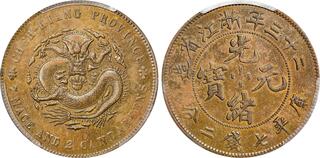| Stack's Bowers Galleries (& Ponterio) > April 2024 Hong Kong Auction | Auction date: 15 April 2024 |
| Lot number: 40004 Price realized: 120,000 USD (Approx. 112,920 EUR) Note: Prices do not include buyer's fees. | Show similar lots on CoinArchives Find similar lots in upcoming auctions on |
| Lot description: (t) CHINA. Chekiang. Brass 7 Mace 2 Candareens (Dollar) Pattern, Year 23 (1897). Esslingen (Otto Beh) Mint. Kuang-hsu (Guangxu). PCGS Genuine--Repaired, Unc Details. L&M-271 (this coin illustrated); K-Unlisted; cf. KM-56 (silver); cf. WS-1012A (unlisted composition, rarity: ★★★★★). It is rather difficult to express the STUNNING RARITY of this tantalizing and historically important pattern crown, as it may in fact be UNIQUE. Similar to other provinces, such as Anhwei and Fengtien, Chekiang had some rather elusive off-metal patterns struck in the waning years of the 20th century, as their fledgling foray into the output of "Dragon Dollars" and their minors was at its dawn. However, such patterns for Chekiang stand as the most formidable of challenges. Similar to the next lot, examples are simply not encountered in the marketplace. The Norman Jacobs example of a Chekiang brass pattern--the smallest denomination in the series, as the "3.2 Candareens" error--realized the then-lofty hammer of $24,000 in August 2008, attesting to the intrigue that it created. Given the immense change within the market of the vintage Chinese series in the decade-and-a-half since, and the fact that this crown--the capstone denomination and one that is plated in the newest edition of L&M--offers so much history and boundless appeal, it is difficult to fathom the heights which it could attain when crossing the auction block. The recent discovery of production material has shone new light on the creation of this coinage. Such findings included patterns, dies, hubs and a series of punches from the archives of the Otto Beh company in Esslingen, Germany. Before this, the origin of the dies used to produce coinage for the provinces of Anhwei, Chekiang, Fengtien, Heilungkiang and Sungarei was only speculated upon. Otto Beh was a specialist in the production of seals and dies. From neighboring Goppingen, Louis Schuler received an order for coining presses in 1895 and commissioned Otto Beh to manufacture the dies. In 1897 and 1898, Beh supplied Schuler with over 200 dies for Chinese coins. At the time, this was the largest order that the company had ever received. Schuler, which started as a Locksmith's shop in 1839, had grown to become one of the world's leaders in metal forming and, in fact, supplied the aforementioned mints with coining presses. To view all items from the KL Collection, click here. From the KL Collection. Estimate: $200000 - $400000 |  |



